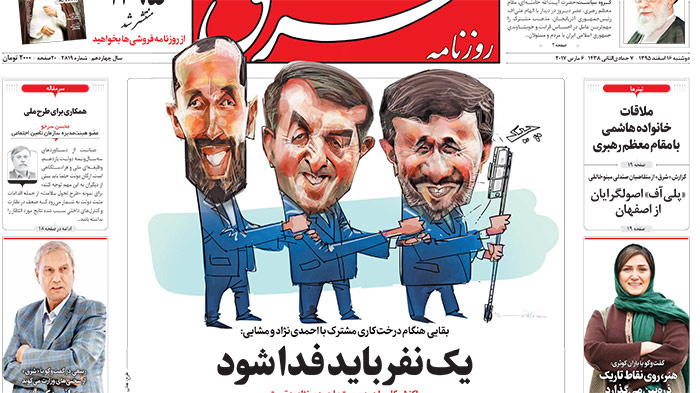Ex-President Ahmadinejad Joins Twitter; But Iranian Twittersphere Is Far from Friendly

(Picture: Front page of Reformist Shargh newspaper with a cartoon of Ahmadinejad and his two close companions, Baghaei and Mashaei.)
It all began on Twitter when ex-President Mahmoud Ahmadinejad’s son, Alireza, made an announcement in a tweet posted last Thursday. “Sunday March 5 will be a day to remember, wait!” read the Persian tweet with accompanying hashtags, ‘cosmopolitan’ and ‘future is bright’. Most observers quickly linked the news to a presidential campaign recently run by a member of the Ahmadinejad administration, Hamid-Reza Baghaei. Although Ahmadinejad himself had pledged not to back any side in the upcoming presidential race, Ahmadinejad’s main man Esfandiar Rahim Mashaei has emphasized a resemblance between Baghaei and Ahmadinejad. Baghaei himself has pledged to seek executive help from his former boss.
Alireza Ahmadinejad’s tweet attracted humorous responses including one that asked if a trial was due for Ahmadinejad the father. However, the promise was kept. On Sunday, the official Arbor Day in Persian calendar, footages made the rounds on social media showing Ahmadinejad and the Baghaei-Mashaei duet busy planting a sapling in a tin box. In one of the videos, Mashaei stood with his hands open, saying he is a tree himself(!), green, and rooted in the pure soil of Iran, echoing symbols used in Ahmadinejadites’ rhetoric that has promised a Government of Spring for almost a decade now. Another short video featured the three, speaking about bravery, love, justice, and martyrdom, with Baghaei adding that in the end, any epic needs a sacrifice.
Openly meant to provoke, the videos angered many Iranians. “Three showmen plant trees with cheap, conspicuous behavior aimed to pretend innocence, serenity, and benevolence after they ruined the country! It is disgusting,” wrote a Twitter user in response.
The dust of the shock had yet to settle when a Twitter account with the handle @Ahmadinejad1956, created in January 2017, began to tweet bilingually in English and Persian. “In the name of God. Peace be upon all the freedom loving people of the world,” said the first tweet with the hashtag #Imontwitter. A minute later, a Persian tweet appeared which hailed freedom, justice, love, and humanity. Third came an authenticating video, in which Ahmadinejad stood looking into the camera, exclaiming in English, “That’s me,” encouraging viewers to follow him. The account’s bio described him as husband, dad, grandfather, university professor, president, mayor, and proud Iranian.
Seen as an open effort to show support for Baghaei, Ahmadinejad’s resurrection was not much welcome either, especially to Iranian users on Twitter. Apart from tons of vitriol that smashed the Ahmadinejad administration for what many see as its destructive handling of economic, foreign, and domestic policies, a large number of users noted, with thumb-down emojis, the fact that Twitter itself was blocked in Iran when Ahmadinejad held office.
Several users wrote that they would never forgive Ahmadinejad as he had ruined the best years of their lives. From the same point of vantage, some users started to warn fellow Iranians against giving Ahmadinejad much publicity. “We laugh and spontaneously publish Ahmadinejad’s video everywhere. That’s exactly what he wants,” complained a tweet. “By tomorrow, the Ahmadinejad squad will be boasting these [very] jokes and mockery as the worldwide coverage of Dr. Ahmadinejad’s joining Twitter,” wrote a user. “You’re so welcoming Ahmadinejad he will decide to run for office again,” joked another. “Many apologies but “they” will come like a joke and we will be messed for real,” read a similar anxious comment.
A counter-argument associated the jokes with a typical Iranian response to catastrophe. “Actually, it’s not Ahmadinejad we’re laughing at. The laugh is our old defense mechanism when we are beyond tears. A hysteric response against their shamelessness,” said a tweet. Out of the same concern, a relatively large group of people suggested that users should block, report, or unfollow the ex-president to show their disapproval.
Photoshopped images of the Twitter bird falling or stricken went viral, with user jesting that Twitter stock had dropped after the ex-president joined. Others noted what they believe is revealing yet another part of Ahmadinejad’s publicity strategy: Ahmadinejad, they wrote, had plagiarized his bio from ex-US president Barack Obama’s Twitter account.
The US factor was seen in plenty of other jokes, especially when it came to the new US President Donald Trump. “Ahmadinejad revived Persian Twitter. We were about to deactivate out of jealousy for Americans and their Trump,” a user wrote. “A Twitter war of words between Trump and Ahmadinejad would be fun. One would swear from the US, and the other responds, saying: Yes, happy New Year,” wrote another, referring to common belief that Ahmadinejad command of English is quite weak. A number of other users said they were waiting for Ahmadinejad to tweet English, in order to pick on him. More pessimistic comment warned against the rise of fascism. “Let’s not be loudspeakers for fascism. Let’s not help the spread of fascism even for laughing. Don’t follow Ahmadinejad. Stand against fascism,” cautioned a user.
Despite all the mockery, in less than 24 hours Ahmadinejad has found more than 15 thousand followers on Twitter, a website blocked in the Iran since June 2009, following riots in Iran caused by allegations of vote rigging in the presidential race that led to Ahmadinejad’s reelection.

